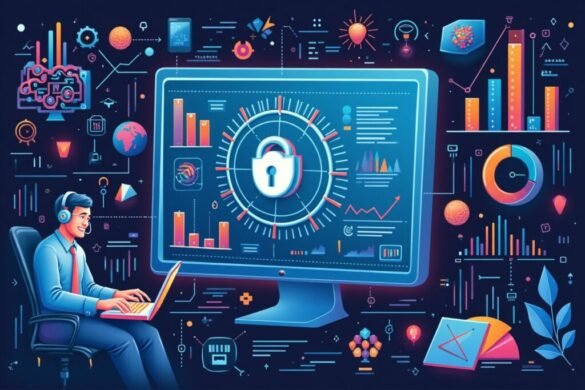Introduction
Cybersecurity has become one of the defining challenges of the digital age. Every day, billions of data points are generated, stored, and transmitted across the internet. Businesses, governments, and individuals all depend on secure systems to protect sensitive information, financial transactions, and even national security. Yet hackers are constantly evolving, using sophisticated tools and strategies to break through defenses.
Traditional cybersecurity solutions—like firewalls, antivirus software, and human monitoring—are no longer enough. The rise of artificial intelligence (AI) is changing the rules of the game. By leveraging advanced machine learning algorithms, AI systems can now analyze vast amounts of data, detect anomalies, and respond to threats in real time. The critical question is: can AI truly outsmart hackers?
In this article, we will explore how AI-powered cybersecurity works, the technologies behind it, its advantages, challenges, and the future of automated defense systems.
The Growing Cybersecurity Crisis
Cyberattacks are growing in frequency and complexity. From ransomware crippling hospitals to phishing scams targeting individuals, the digital threat landscape is vast and relentless. According to recent reports, cybercrime damages could reach $10 trillion annually by 2030, making it one of the greatest economic risks globally.
Some of the most concerning trends include:
- Ransomware attacks shutting down critical infrastructure.
- State-sponsored hacking targeting national defense and political institutions.
- AI-driven attacks, where hackers themselves use machine learning to bypass security.
- IoT vulnerabilities, as billions of connected devices create new attack surfaces.
The sheer volume of threats makes it impossible for human teams alone to detect and respond effectively. This is where AI-powered cybersecurity steps in.
How AI Works in Cybersecurity
AI is transforming cybersecurity by automating tasks that were once slow and manual. Instead of relying on fixed rules or signatures of known malware, AI systems learn from patterns in data.
Key technologies include:
Machine Learning (ML)
ML algorithms can identify suspicious patterns in network traffic, emails, or files. For example, if an employee’s account suddenly logs in from a foreign country at an unusual hour, ML can flag this as suspicious.
Natural Language Processing (NLP)
NLP helps cybersecurity systems analyze phishing emails, chat logs, or malicious code that uses human-like language to trick users.
Behavior Analytics
AI tracks normal user behavior and raises alerts when anomalies occur. If a user suddenly downloads massive amounts of data or accesses restricted files, AI can detect it instantly.
Automated Threat Response
AI doesn’t just identify threats—it can also respond. For example, it can isolate infected devices, shut down compromised accounts, or block malicious IP addresses in real time.
Real-Time Detection and Response
One of the greatest strengths of AI in cybersecurity is its ability to detect and respond instantly. Traditional security systems often rely on signatures of known malware. This means they struggle against zero-day attacks—new threats that haven’t been seen before.
AI, on the other hand, uses predictive models. By analyzing unusual behavior, it can catch even previously unknown threats. In industries like healthcare or finance, where every second matters, this real-time capability is revolutionary.
Benefits of AI-Powered Cybersecurity
The adoption of AI brings several clear advantages:
- Speed – AI can analyze millions of events per second, far beyond human capacity.
- Scalability – It can protect large networks, cloud infrastructures, and IoT ecosystems.
- Accuracy – Machine learning reduces false positives by learning from past incidents.
- Cost Efficiency – By automating detection and response, AI reduces the need for massive human teams.
- Adaptability – AI systems improve over time as they learn from new threats.
Challenges of AI in Cybersecurity
Despite its promise, AI in cybersecurity is not without challenges.
- Adversarial Attacks: Hackers can feed false data to AI models, tricking them into ignoring threats.
- Bias in Data: If training data is incomplete or biased, AI may overlook certain threats.
- Over-Reliance: Businesses may trust AI too much, neglecting human oversight.
- High Costs: Implementing advanced AI systems can be expensive for smaller organizations.
- AI vs AI: Hackers are also using AI, creating a technological arms race.
AI in Action: Real-World Examples
Several companies and governments are already deploying AI-powered cybersecurity:
- Darktrace: Uses AI to detect anomalies in enterprise networks, often referred to as the “immune system” for IT.
- CrowdStrike: Employs AI to detect and stop endpoint attacks.
- Microsoft and Google Cloud Security: Integrate AI models to monitor global cyber threats.
- Financial Institutions: Use AI to detect fraud in credit card transactions in milliseconds.
These examples show that AI isn’t just a future concept—it’s already reshaping cybersecurity today.
The Human-AI Partnership
While AI is powerful, it cannot replace humans entirely. Hackers are creative, often exploiting social engineering and psychological manipulation rather than pure technical flaws. Humans are still essential for strategic decision-making, interpreting alerts, and designing security policies.
The future lies in a human-AI partnership, where machines handle the speed and scale of threat detection while humans provide judgment, ethics, and oversight.
Preparing for the AI Cybersecurity Future
Organizations must take steps now to prepare for an AI-driven cybersecurity future:
- Invest in AI tools that integrate with existing security infrastructure.
- Train employees to work alongside AI, interpreting alerts and acting on insights.
- Adopt zero-trust frameworks to reduce vulnerabilities.
- Stay ahead of regulations, as governments are developing rules around AI and cybersecurity.
- Experiment with adversarial testing, using red teams to identify weaknesses in AI defenses.
The Road to 2030
By 2030, AI is expected to be the backbone of cybersecurity. Instead of reacting to attacks, businesses will rely on proactive, predictive AI models. Hackers will continue to evolve, but AI will evolve faster, creating a dynamic battlefield where agility matters most.
In this new era, the organizations that combine AI with human expertise will have the greatest chance of staying secure.
Conclusion
The rise of AI-powered cybersecurity marks a turning point in the fight against digital threats. By analyzing vast amounts of data, detecting anomalies, and responding instantly, AI has the potential to outsmart hackers in real time.
But the battle is far from over. Hackers are also leveraging AI, and new forms of cyberwarfare are on the horizon. Success will depend on balance: letting AI handle speed and complexity, while humans provide strategy and ethical oversight.
The future of cybersecurity is not simply AI replacing humans—it is humans and AI working together. By 2030, this partnership may be the only way to stay ahead in an increasingly dangerous digital world.

